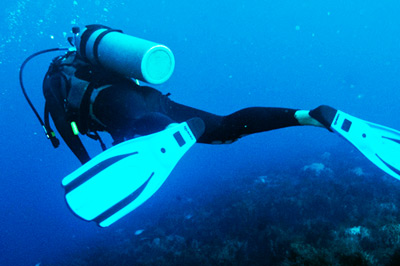While sitting here contemplating how long it’s been since I’ve gone scuba diving (answer: way too long), it occurred to me that one can draw many parallels between the avocations of scuba diving and marine aquarium keeping. I’m not referring to the observation of marine life here—though that’s unquestionably a major element of both activities—but to certain rules or best practices that apply to both.
Okay, right now you’re probably thinking to yourself, “Maybe it’s a good thing this guy hasn’t been diving in a while—he’s obviously skipped one safety stop too many or really bungled his dive tables!” But fear not, I’ll bring it back around. (In other words, humor me!)
So, with no further ado:
Plan your dive and dive your plan
Diving is safest and presents the fewest unforeseen contingencies when you plan ahead of time who will be diving with whom, how deep you’re going to go, the path you’re going to follow, when you’re going to ascend, etc.—and then adhere strictly to that plan.
To my (nitrogen-addled) mind, the marine aquarium analog to this is carefully planning and researching the animals you want to keep, as well as the order in which you’ll introduce them, and then sticking with that stock list. This doesn’t mean you can’t make sensible substitutions if necessary, but it will help you avoid making impulse purchases that can throw your whole plan into chaos. Plus, knowing which animals you’re going to keep will help you make the most appropriate equipment purchases.
Come back with air to spare
All divers are taught to return to the boat/shore with at least 500 psi remaining in their tank. This encourages proper monitoring of air consumption and provides a margin of error that could prove invaluable, even lifesaving, in any number of contingencies.
I equate this to stocking a marine aquarium lightly so you have a solid margin of error when it comes to the buildup of dissolved pollutants or the loss of some biofiltration capacity.
Never skip your safety stop
Divers are also taught to perform a 3- to 5-minute safety stop at a depth of 15 to 20 feet before surfacing as a hedge against decompression sickness. I might add that the safety stop also presents an opportunity to observe pelagic species that are all too easy to overlook when you’re focused exclusively on the reefs—but I digress!
Regular Saltwater Smarts visitors can probably guess which element of marine aquarium keeping I would correlate with the safety stop: That’s right, quarantining all new specimens for at least 4 weeks before moving them to your display tank as a hedge against introducing disease.
Don’t cheap out on equipment
Both scuba diving and marine aquarium keeping are “equipment-intensive” activities. As a diver, your life very literally depends on the equipment—the BC, regulator, dive computer, etc.—you invest in. Similarly, the health and survival of the marine livestock in your care depends on gear you purchase—the tank, lighting (for photosynthetic invertebrates), heater, protein skimmer, submersible pumps, etc. In either case, discount equipment that soon breaks down or performs unreliably is no bargain!



